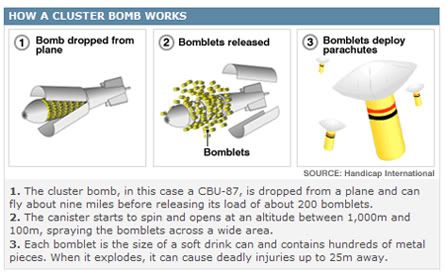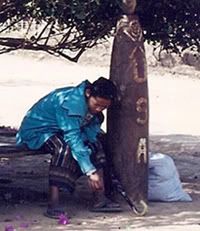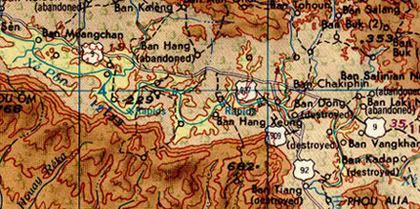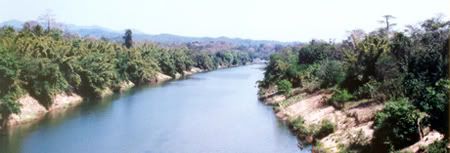( – promoted by buhdydharma )
A new cluster munitions treaty was adopted in Dublin, Ireland on May 30th. As per Human Rights Watch:
The treaty immediately bans all types of cluster munitions, rejecting initial attempts by some nations to negotiate exceptions for their own arsenals, as well as calls for a transition that would delay the ban for a decade or more.
In addition to the prohibitions on use, production, stockpiling, and trade, the treaty also includes very strong provisions requiring states to provide assistance to victims and to clean up areas affected by cluster munitions.
Human Rights Watch urged governments supporting the treaty to make all necessary preparations to sign the treaty in Oslo in December 2008. The treaty will go into effect after 30 nations have signed and ratified it.
The US and other countries which have used or stockpile cluster bombs were was absent from the negotiations. These include Russia, Israel, China, Brazil, India and Pakistan.
 Cluster bombs have been used in Iraq, in Afghanistan, Lebanon, Yugoslavia, Cheznya, Viet Nam, Cambodia and in Laos.
Cluster bombs have been used in Iraq, in Afghanistan, Lebanon, Yugoslavia, Cheznya, Viet Nam, Cambodia and in Laos.
Between 1964 and 1973, US aircraft dropped two million tons of bombs on Laos, a country with a population at the time of around 2.4 million people. These bombs included 277 million cluster bomblets or “bombies”, as the Lao people call them. A typical failure rate is around 30 per cent and so it is estimated that some 84 million of these were left lying around on and in the ground in Laos.
 Much of the bombing took place on the Plain of Jars and also in eastern Laos along the network of trails and roads which were referred to by the Americans as the Ho Chi Minh Trail. The local people, the Viet and Lao, knew it as the Truong Son Road as it coursed along the western side of the Truong Son Mountain Range that separates the two countries.
Much of the bombing took place on the Plain of Jars and also in eastern Laos along the network of trails and roads which were referred to by the Americans as the Ho Chi Minh Trail. The local people, the Viet and Lao, knew it as the Truong Son Road as it coursed along the western side of the Truong Son Mountain Range that separates the two countries.
Laos was a dumping ground for US pilots returning to Udorn Thani and other air bases in Thailand from bombing raids in Vietnam. They were ordered to return with no bombs on board.
Contrary to what many people believe, rather than thick jungle and tropical rain forest, the Trail through this region traversed an area of small farms and villages. Many of of these villages were literally wiped off the map including the town of Sepon which was bombed to rubble. Maps of the area compiled in the early 70’s show many villages as “abandoned” or “destroyed”, as shown on the map below.
It was nearly ten years ago that I traveled to this area. I went with a friend, a native Lao speaker, by bus from Savannakhet. It was a bumpy ride over a well worn, poorly surfaced road – Hwy 9. We stopped for lunch at a roadside restaurant along the way. The featured item on the menu was grilled rice paddy rat. The trip took the entire day.
By late afternoon we had reached the end of the line, the site of the former town of Sepon. As darkness began to descend we realized that there was no place to stay in the area where “old” Sepon had once stood. We talked with some of the local people and one family offered us a room in their home and we spent two nights there. The owner told us how the government had offered people free land adjoining the main road in return for clearing the UXO from it.
The photo below was taken from a new pedestrian / motorbike / bicycle bridge at at the point of a river crossing, the Sepon River, on one of the many legs of HCM Trail, near the village of Ban Dong. A local man took us for a walk through an area where he said a large battle had been fought during Operation Lam Son 719. I found it interesting how he referred to the two warring sides, one “the Vietnamese” the other “the Saigon Army”. There was UXO lying on the ground and a lonely rusting hulk of a US made tank with ARVN markings.
Unexploded cluster bombs and other ordinance pose enduring threats to innocent people. Searching for UXO (unexploded ordinance) for sale as scrap is a source of income and also has practical uses. In the Sepon River Valley we saw large bombs which had been cut in half lengthwise and made into small boats. Unexploded bombs have been used as support columns for the traditional style Lao homes and other structures built up on “stilts”.
The best figure for casualties caused by cluster bombs is 4,847 since the end of the war, almost half of them children. Deadly explosives have become part of everyday life. In the town of Phonsavan there are fences made of shell casings. Unexploded bombs are forged into axes, sickles, cow bells, rice cookers, belt buckles, boats and ladders. One particular cluster bomb with a tripod-shaped fin is commonly fitted with a light bulb and used as a lamp.
“This familiarity is a real problem,” said Joe Pereira, a British occupational therapist whose charity, Cope, supplies prosthetic limbs to victims. “People grow up with bombs in their houses and so when they see them in the forest they don’t appreciate the danger.”
Handicap International had recently begun a clean-up program for UXO in the area around Sepon when we were there. The group working at Ban Dong was led by a former British Royal Navy officer with a team of about a dozen Lao young people. I asked the former British officer how they went about finding the UXO. He told me that it was not difficult, that they just walked through an area, spotted the UXO lying on the ground and then marked the locations with small plastic flags. Depending on how dangerous it was the UXO was either blown in place or carefully removed and taken to a UXO disposal area to be exploded under controlled conditions.
Because the (cluster bomb) fragments travel at high velocity, when they strike people they set up pressure waves within the body that do horrific damage to soft tissue and organs: even a single fragment hitting somewhere else in the body can rupture the spleen, or cause the intestines to explode. This is not an unfortunate, unintended side-effect; these bombs were designed to do this.
Source – graphic image warning!
“We refer to cluster bombs as the weapon that never stops killing,” said Peter Herby, of the International Committee of the Red Cross, which is lobbying for an unconditional ban. “It’s bad enough when civilians get caught up and injured in conflict. But for us it’s repugnant when killing goes on for years and decades simply because of the wrong choice of weapon. In the end politicians have to decide that some weapons are beyond the pale.”
Meanwhile in Laos –
…experts here, noting that unexploded bombs from World War I still turn up in Belgium, doubt that this little country will ever be free of cluster bombs. “Many people ask me how long this project will go on. I say, 50 years, 100 years,” UXO Lao director Bounpone Sayasenh says. “The bombies are everywhere.”
from USA Today.
More recently cluster bombs have been fired into Lebanon, used in Iraq and in Afghanistan. A Google search will provide many more links. The killing continues after all these years.
Will justice ever be rendered?
Also at GOS



5 comments
Skip to comment form
Author
Not a pleasant topic but it’s one we should not forget.
Some petitions I found by following your links:
Handicap International’s Cluster Bombs Campaign
and
the People’s Treaty from Mines Action Canada:
Now your handle will mean a lot more to me.
Jody Williams, our local Putney girl, made a significant impact on landmines through citizen activism. You are doing the same. Keep up the good work.
PS Thanks for the warning on graphic material. I try to avoid getting gruesome images in my head. It’s enough that I know about it. Much appreciated.
Author